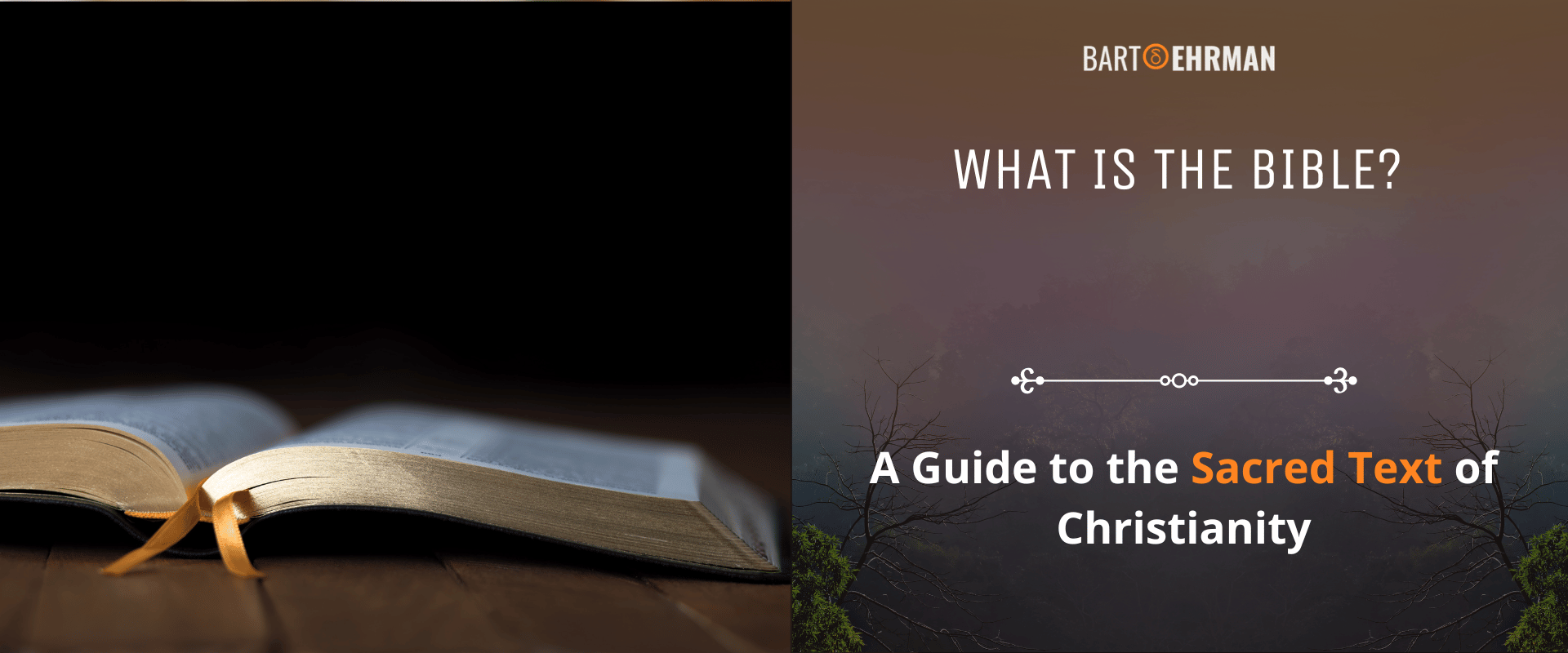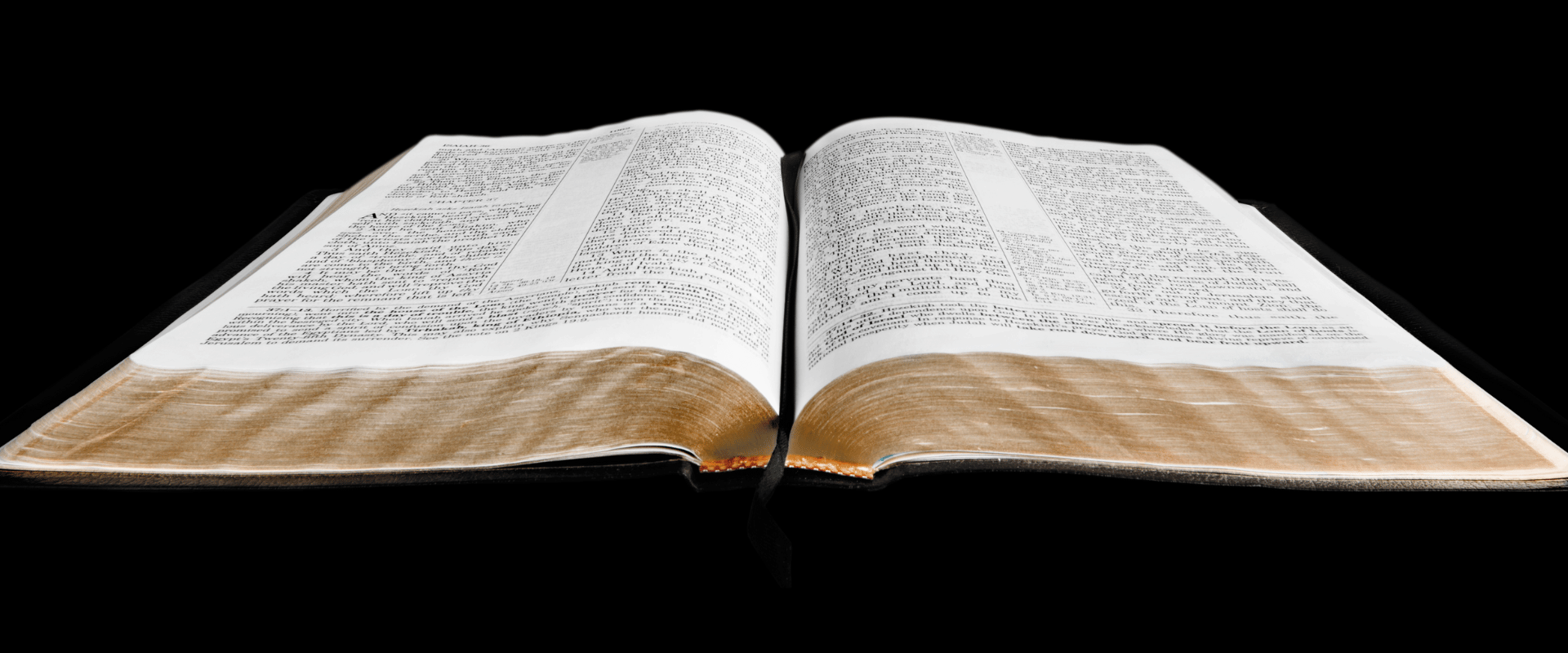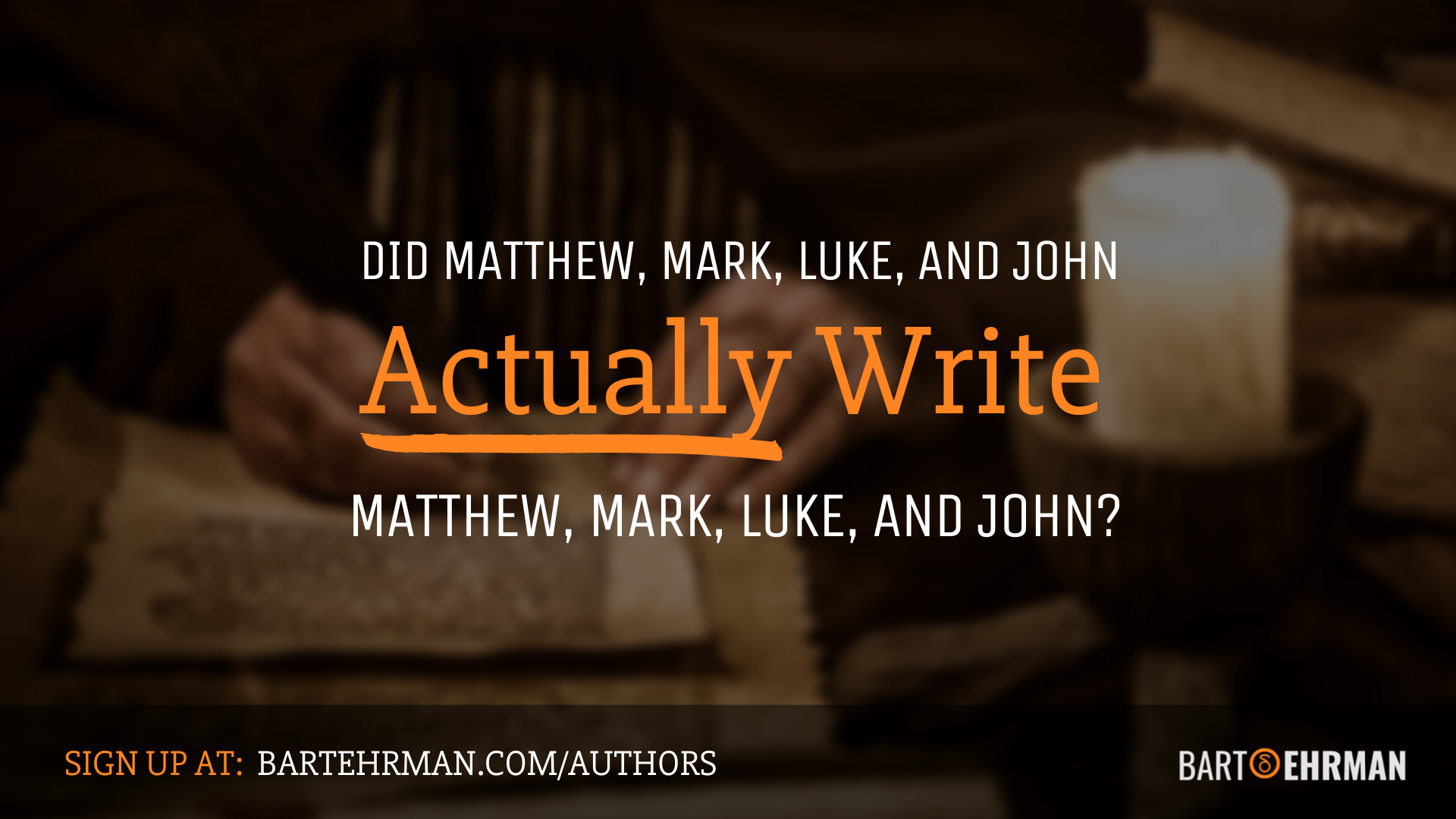What is the Bible? A Guide to the Sacred Text of Christianity

Written by Joshua Schachterle, Ph.D
Author | Professor | Scholar
Author | Professor | BE Contributor
Verified! See our editorial guidelines
Verified! See our guidelines
Edited by Laura Robinson, Ph.D.
Date written: February 22nd, 2024
Disclaimer: The views and opinions expressed in this article belong to the author and do not necessarily match my own. - Dr. Bart D. Ehrman
What is the Bible? Perhaps this seems like a silly question. We all know what the Bible is, right? And yet, sometimes the most obvious questions provide the most interesting insights.
We know that the Bible is the sacred text of Christianity, but how did it get that way? When was the Bible put together? What are its origins? What does it consist of? These are important questions. Let’s take a deep dive into this fascinating subject.

Can We Even Make A Summary of the Bible?
This is indeed a daunting task! However, if we approach a summary of the Bible systematically, it can be done.
The first thing to keep in mind when attempting to summarize the Bible is that it’s not one book. That is, unlike War and Peace or The Da Vinci Code, the Bible is not a single book written by a single author. Instead, it is a compilation of many books written by many authors in many different contexts.
Timothy Beal writes that rather than thinking of the Bible as a book, it makes more sense to think of it as a library. Think about it: a library is filled with many different books written by many different people. In addition, no one expects every book in a library to agree with every other book and even though the books in a library may be catalogued in a certain order, no one expects readers to read them in that order.
If we accept this analogy, we can find endless fascination in the Bible without expecting it to be univocal (speaking with one unified perspective) or consistent. Having said this, let’s examine the history of the Old and New Testaments.
The Old Testament in Summary
The Old Testament, known in Hebrew as the Tanakh, consists of three main sections. These are known as the Torah (Law, also called the Pentateuch), the Neviʾim (Prophets), and the Ketuvim (Writings).
The Torah consists of the books of Genesis, Exodus, Leviticus, Numbers, and Deuteronomy. It’s content covers the creation of the world, the stories of the Jewish patriarchs like Abraham, Isaac, and Jacob, the Israelite exodus from Egypt, God’s granting of the Law to Moses at Sinai, and the wanderings of the Israelites in the desert which culminate in their arrival at the Promised Land.
The Nevi’im are the prophetic books and consist of Joshua, Judges, 1st and 2nd Samuel, and 1st and 2nd Kings, – known as the Former Prophets – the Latter Prophets, Isaiah, Jeremiah, and Ezekiel, and the twelve minor prophets Hosea, Joel, Amos, Obadiah, Jonah, Micah, Nahum, Habakkuk, Zephaniah, Haggai, Zechariah, and Malachi. The Nevi’im consists of narratives and prophecies that focus on moral and religious guidance, the actions and destinies of Israel and its people, and the messages of warning, comfort, and hope delivered by God's messengers. It spans from the conquest of Canaan to the Babylonian exile, highlighting the relationships between God, the prophets, and the people of Israel.
Finally, the Ketuvim are a diverse collection consisting of poetry, wisdom literature, and some historical texts. They include such books as Psalms, Proverbs, and Job which offer both poetic texts and theological musings, and books like Daniel and Esther which are histories of the Jewish people under foreign rule.
When Was the Old Testament Put Together?
Joseph Blenkinsopp writes that the first five books of the Old Testament – the Torah or Pentateuch – achieved the form we have now during the Persian period between 538–332 BCE. He surmises that their authors were among those who returned to rebuild the Jewish homeland after the long exile in Babylon.
Next come the books of Joshua, Judges, Samuel, and Kings which John Rogerson says were written during the Babylonian exile in the 6th century BCE. This is why these books cover more of Israel’s history in an attempt to maintain their identity and traditions. Scholars believe these books began as a single work they call the Deuteronomistic History which covers the conquest of Canaan up to the Babylonian siege of Jerusalem in 587 BCE.
The books of 1st and 2nd Chronicles cover much of the same historical material as the Pentateuch and Deuteronomistic History and, according to Lester Grabbe, were likely written in the 4th century BCE. Chronicles, and Ezra–Nehemiah were in their finished form sometime during the 3rd century BCE.
John Miller notes that Isaiah, Jeremiah, Ezekiel, and the twelve so-called minor prophets were all composed between the 8th and 6th centuries BCE. The prophetic books Jonah and Daniel, however, were written much later, Jonah between the 4th and 5th centuries BCE and Daniel between the 3rd and 2nd centuries BCE.
But if these books were all written at such different times, when did they become a canon, a final unified unit? It was a long and complex process.
Even by Jesus’ time, there was no fixed canon, although many of the books in our current Old Testament were certainly considered Scripture. There were other books that would ultimately be excluded, however, like the 14 books of the Apocrypha. According to Martin Goodman, it’s highly likely that the writings of the Apocrypha were initially accepted by many Jews as inspired Scripture. However, they were later disputed and eventually left out of the canon.
We don’t have a lot of detailed information about when and how the Old Testament canon was officially canonized into its present, 39-book form, but scholars generally agree that it had solidified by the end of the 1st century CE.
However, in the Jewish tradition, the canon is often counted as 24 books because certain books are grouped together differently, such as the twelve minor prophets being counted as one book.
Lee Martin McDonald and James Sanders note that the current twenty-four books were canonized in three stages: The Torah around 400 BCE, the Prophets around 200 BCE, and the Writings around 90-100 CE. These dates are far from certain but give us a basis for discussion.
One well-known story attempts to explain how the Hebrew Bible officially became a closed canon, no longer admitting new books. When Rome destroyed the Jerusalem Temple in 70 CE, one rabbi, Yochanan ben Zakkai, moved to the Palestinian city of Yavneh. Here, he established a center of Jewish learning. Twenty years later in 90 CE, Rabbi Zakkai convened a council of well-known rabbis which ultimately chose the twenty-four books used today.
The facts of this story are highly questionable, according to most scholars. However, it might indicate a general time-frame by which the Hebrew canon might have been formally closed.
The New Testament in Summary
The current New Testament also had a long, complex process of composition, including debates about theology and authenticity before it became canonized.
Its 27 books consist of the following:
The four Gospels (Matthew, Mark, Luke, John)
The Acts of the Apostles
Thirteen Pauline epistles
Seven Catholic epistles
The Book of Revelation
The Gospels were written in the second half of the 1st century (and possibly the first years of the 2nd in the case of John). The first, Mark, was written around 70 CE when the Romans had destroyed the Temple in Jerusalem. Matthew and Luke, who used Mark as a source, were written between 80-85 CE. John was written between 90-110 CE.
All four tell the story of Jesus’ life, death, and resurrection, although as L. Michael White notes, each of the four has a slightly different focus.
The Acts of the Apostles is a book about the early years of the church after Jesus’ resurrection and assumption. It was written by the unnamed author of Luke and is actually a 2nd part to the Gospel of Luke. It begins with the disciples at Pentecost, follows Peter on missionary journeys and then transitions to Paul’s missionary journeys, ending with Paul’s arrest and transport to Rome.
The Thirteen Pauline epistles, mostly written to communities of Jesus-followers Paul had founded, can be divided into three categories. First, the seven authentic letters of Paul which are the earliest Christian writings in existence. According to most scholars, they were probably written in this order:
Next, we have the Deutero-Pauline epistles. Bart Ehrman and most other scholars agree that while these were written in Paul’s name, they were written by someone else after Paul’s death. Why? The letters are different in terms of linguistic style, vocabulary, and theology from the undisputed Pauline letters, and talk about circumstances that reflect a time period after Paul’s death in 64 CE. They include the following:
Finally, we have the pastoral letters, again written in Paul’s name but almost certainly not written by him according to the vast majority of scholars. These were likely written in the early 2nd century:
The Book of Hebrews is sometimes included in the list of Pauline epistles, since some early Christians believed it was written by Paul. However, its author never claims to be Paul and it’s so different from his authentic letters that no scholars believe it was written by Paul.
Then we have the catholic epistles (catholic here means “universal” or “general”). They are called this because unlike Paul’s letters, they are not addressed to specific communities but to Christians in general. These include the following:
Finally, we have the Book of Revelation. This is an apocalypse, written around 95 CE according to most scholars. Like all apocalyptic literature, this book envisions God returning to clean up the world, punishing the wicked and rewarding the righteous, namely those who stay faithful to Jesus for this author.

So how did this list of distinct books become one unit?
Christian authors, beginning in the second century made lists of the New Testament books they thought were worthy to be called Scripture.
Bishop and heresy-fighter Irenaeus of Lyons (130-202 CE) included all four of the Gospels in our current New Testament, making it clear that all four were generally accepted by the mid-2nd century. However, he also included the Shepherd of Hermas, and the Book of Wisdom, two books that would later be excluded.
Theologian Clement of Alexandria (150-215 CE) listed other apocryphal books in his canon list. These include the Letter of Barnabas and the Apocalypse of Peter, both of which would eventually be excluded from the canon.
By the 4th century, church historian Eusebius of Caesarea (260-339 CE) made a much larger list than his 2nd and 3rd-century forebears. He included a list of books that were contested, the first of which was Revelation. He also included James, Jude, 2nd Peter, and 2nd and 3rd John as books that he believed should not be designated as Scripture. All of these books, Revelation included, would later become part of the canon.
Fourth-century priest, translator, and scholar Jerome (342–347 – 420 CE) chose the same list of 27 books as we have now, although he was not the first to list these books. His list was important, however, because Jerome would write the final Latin translation of the Bible, known as the Vulgate.
Jerome’s contemporary, Augustine of Hippo (354-430 CE), had the same list as Jerome. His list would greatly influence later church councils ratifying the canon.
However, the first person to list the 27 books we now know as the New Testament was the embattled 4th-century bishop of Alexandria, Egypt Athanasius.
Athanasius wrote a yearly letter to Christians in his diocese defining correct doctrine and other points of orthodoxy. In the letter from 367 CE, however, Athanasius took a stand on which books of the Bible were officially canon. His list of Old Testament books differed from our current list. However, he included all twenty-seven of the books that currently make up our New Testament canon.
Many believe that the church councils such as the Council of Nicaea debated the canon. However, Bruce Metzger notes that when the councils did address the biblical canon, they simply confirmed what the church was generally already using. For example, at the Council of Laodicea in 363 CE, the church approved a 26-book New Testament, excluding Revelation. This was already the general consensus of churches at that time.
The next councils to speak of the canon were the Councils of Hippo (393 CE) and Carthage (397 CE). They approved what would become the Catholic canon under the massive influence of Augustine (354-430 CE). In a book called On Christian Doctrine, Augustine wrote that “the canon of the sacred writings [is] properly closed.” That is, no new books could be added.
The Bible’s Significance Today
The Bible has become such an iconic book that it’s almost impossible to underestimate its importance.
For Jews, the Hebrew Bible or Tanakh offers a record of Jewish history, directives for their faith practices, and encouragement for everyday living. It’s used in religious ceremonies but also read daily for study and prayer.
For Christians, the Bible has much the same function as . Martin Luther, the first Protestant, formulated a doctrine of sola scriptura, “only scripture,” believing that the sacred text of Christianity held everything necessary for Christian life. Many Protestants continue to believe this today, although many think this is too much emphasis on one faith source.
I wrote earlier that one could conceive of the Bible as a library, a collection of diverse texts that don’t necessarily agree with each other and hold different answers, rather than a single book. What would happen if we viewed it this way instead of as the ultimate book of divine answers? To be sure, those of faith would really have to wrestle with some of the contradictions, but could that be beneficial to one’s faith rather than detrimental? I suspect the answer is yes.
Conclusion: What is the Bible?
The Bible as we know it today consists broadly of two large sections: the Old Testament (or Hebrew Bible) and the New Testament. Both consist of a number of disparate sources written by different people for different purposes in different historical contexts. How did this come to be seen as one book?
The Old Testament writings went through a long, complicated process of canonization, ultimately becoming a closed list of 39 books by the end of the 1st century CE. Likewise, the New Testament went through a long process of composition followed by theological debates ending by approximately the 4th century with a closed canon of 27 books.
Whether you are a religious person or simply curious, it would behoove you to learn more about this highly influential book (or library?) if only to understand where Jews and Christians are coming from and how it has influenced history and culture for centuries.
FREE COURSE!
WHY I AM NOT A CHRISTIAN
Raw, honest, and enlightening. Bart's story of why he deconverted from the Christian faith.
Over 6,000 enrolled!

